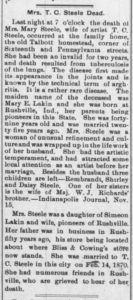
Theodore Clement Steele, American, 1847–1926
1899
Oil on canvas
56.51 cm x 74.29 cm | 22.25 in x 29.25 in
Signed and dated lower right, private collection
T.C. Steele, his wife Libbie and their daughter Daisy spent the summer of 1899 in Tennessee. This was precipitated by the failing health of Libbie (Mary Elizabeth Lakin Steele) who had been in poor health since 1895, and diagnosed with tuberculous in 1899. Steele believed the cool, clear mountain air of the Tennessee Appalachian Mountains would be helpful.
First locating to the town of Roan Mountain in the Appalachians on the Tennessee-North Carolina border, they were dissatisfied with the town and quickly moved to Lost Cove, a narrow valley where they rented a cottage. Above them rose Roan Mountain and its impressive summit. The Steele’s remained in Lost Cove for three weeks; Libbie had been bedridden since their arrival in Tennessee.1
Steele’s time in Tennessee is important to his body of work and only a handful of these Tennessee paintings are known to exist. One is on public display and available for viewing: Tennessee Mountain Land, at the David Owsley Museum of Art, Ball State University, Muncie, Indiana.
Returning to Indianapolis around September 9, Libbie died on November 14 at the age of forty-nine. She is buried in Crown Hill.
Steele said many times to friends “My wife was my most helpful critic, she brings to me a clearer eye – a more poetic vision”.1
1 The Passage – Return of Indiana Painters from Germany: 1880-1905, Martin F. Krause, curator of Prints and Drawings (retired) at the Indianapolis Museum of Art. Indianapolis Museum of Art and the Wallraf-Richartz Museum, Cologne, Germany in cooperation with Indiana University Press, 1990.
2The Rushville Republican (Rushville, Indiana), 17 November 1899, Friday, pg. 4.


